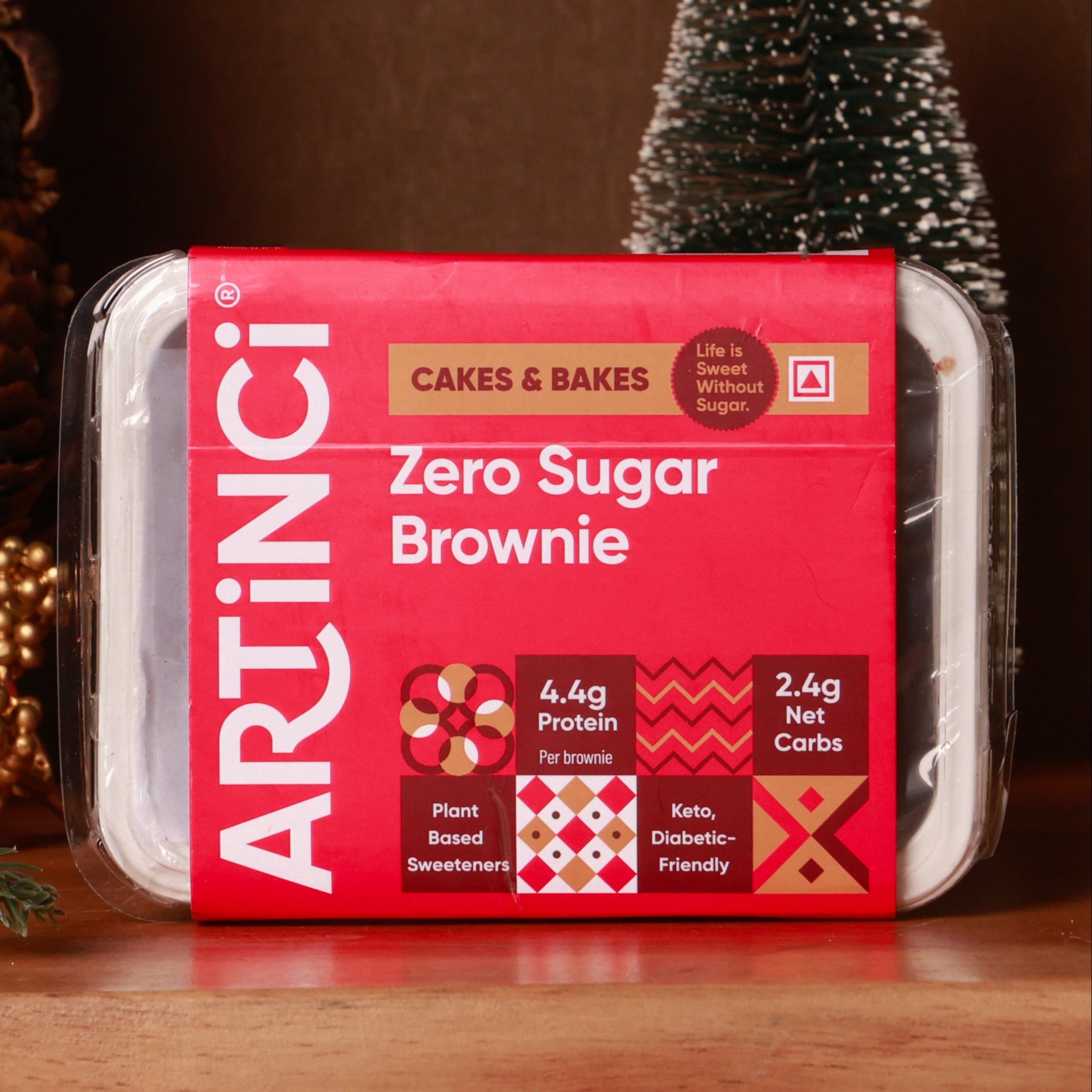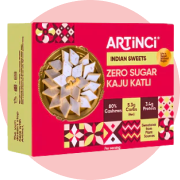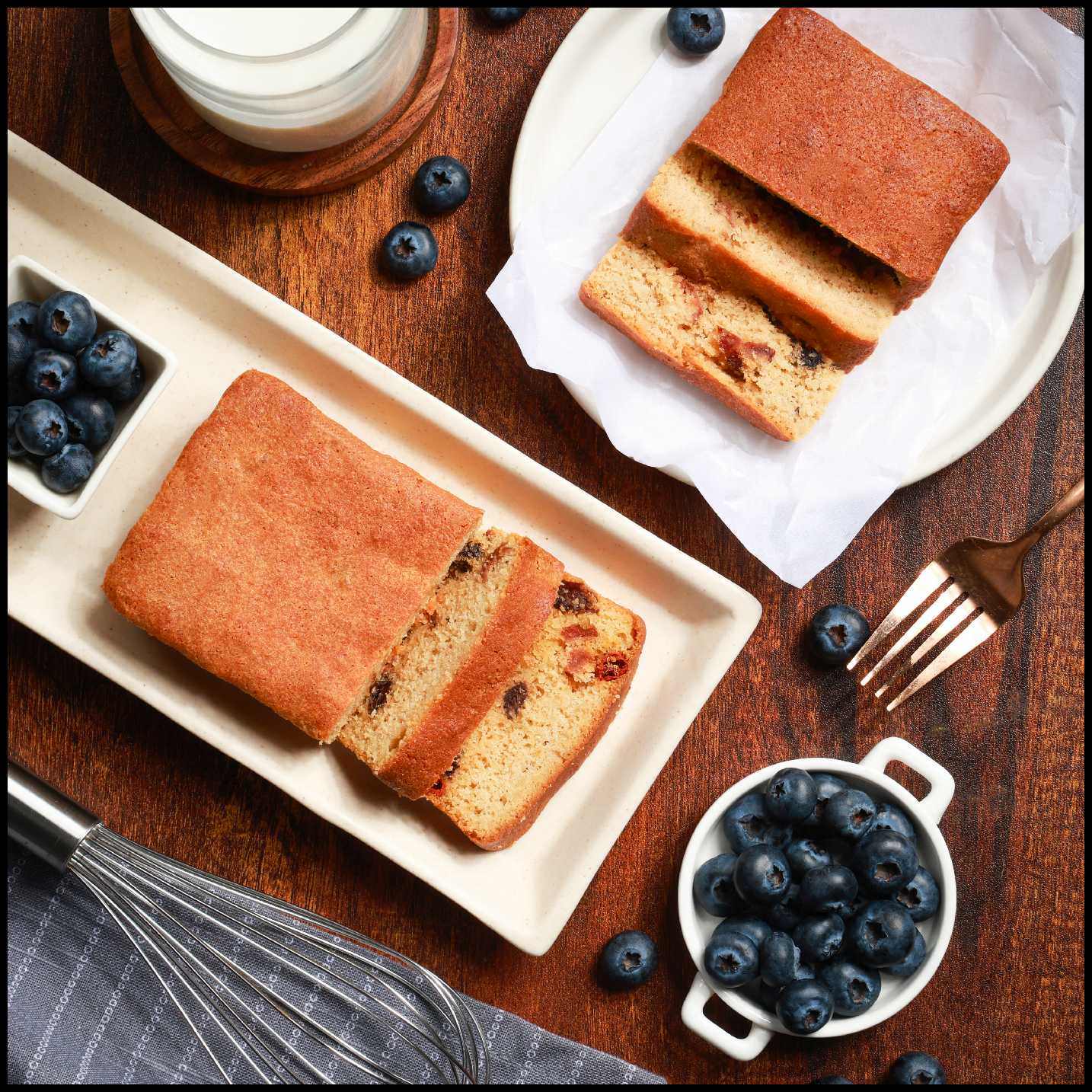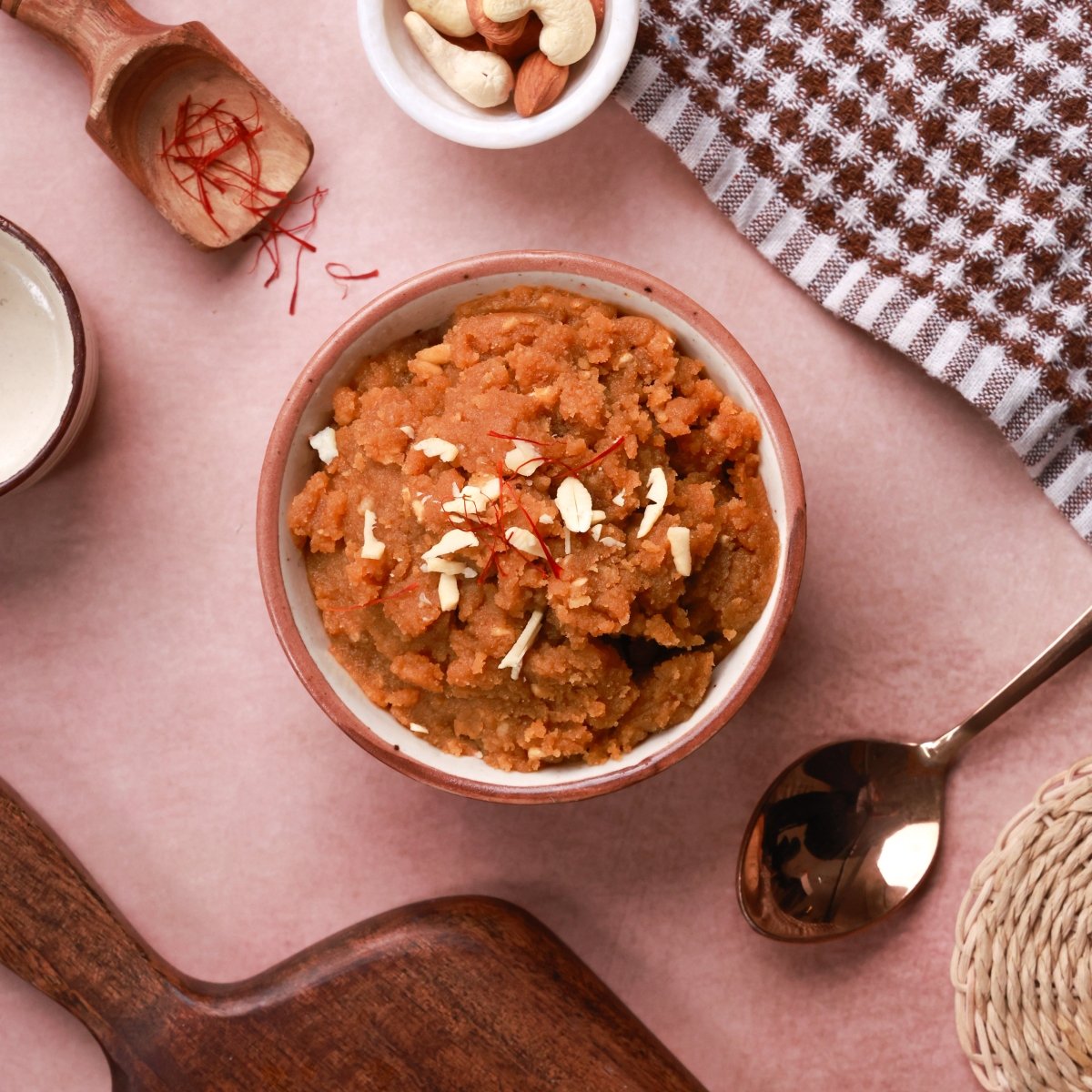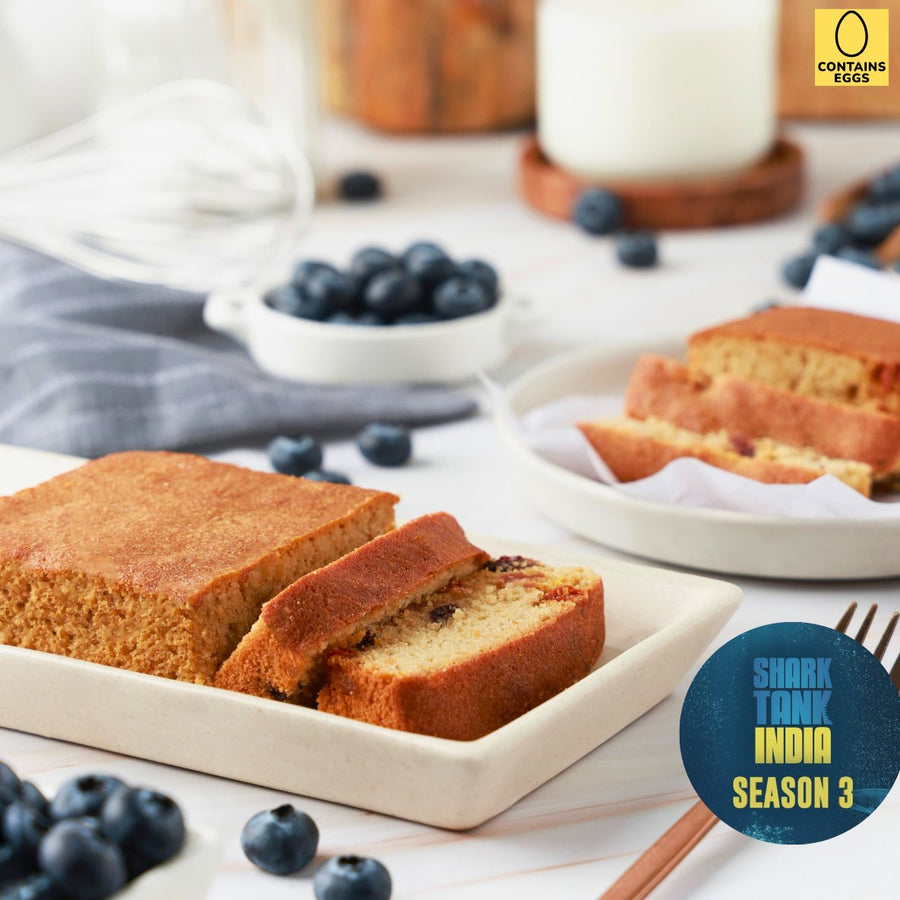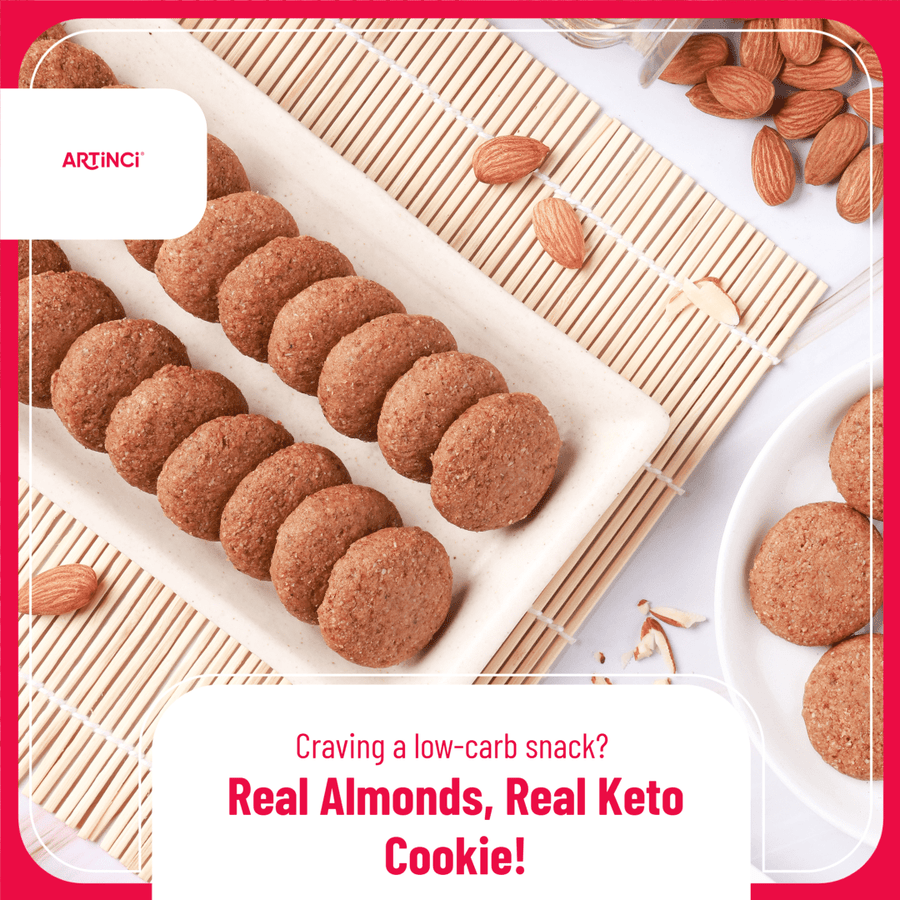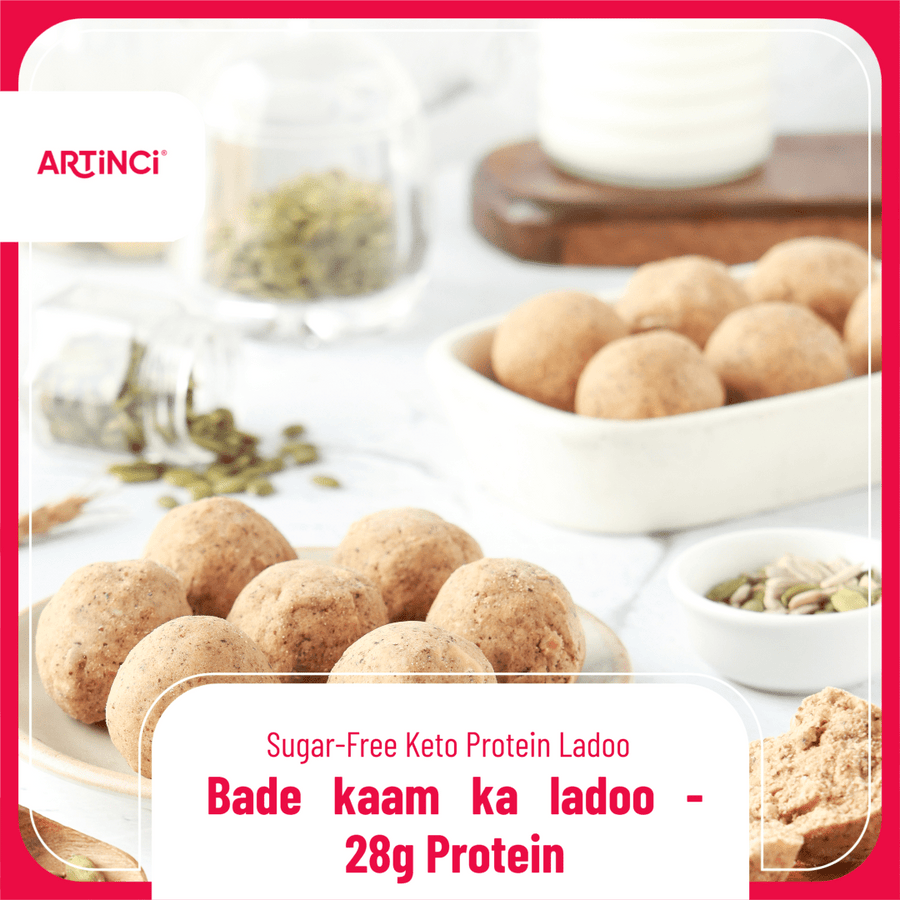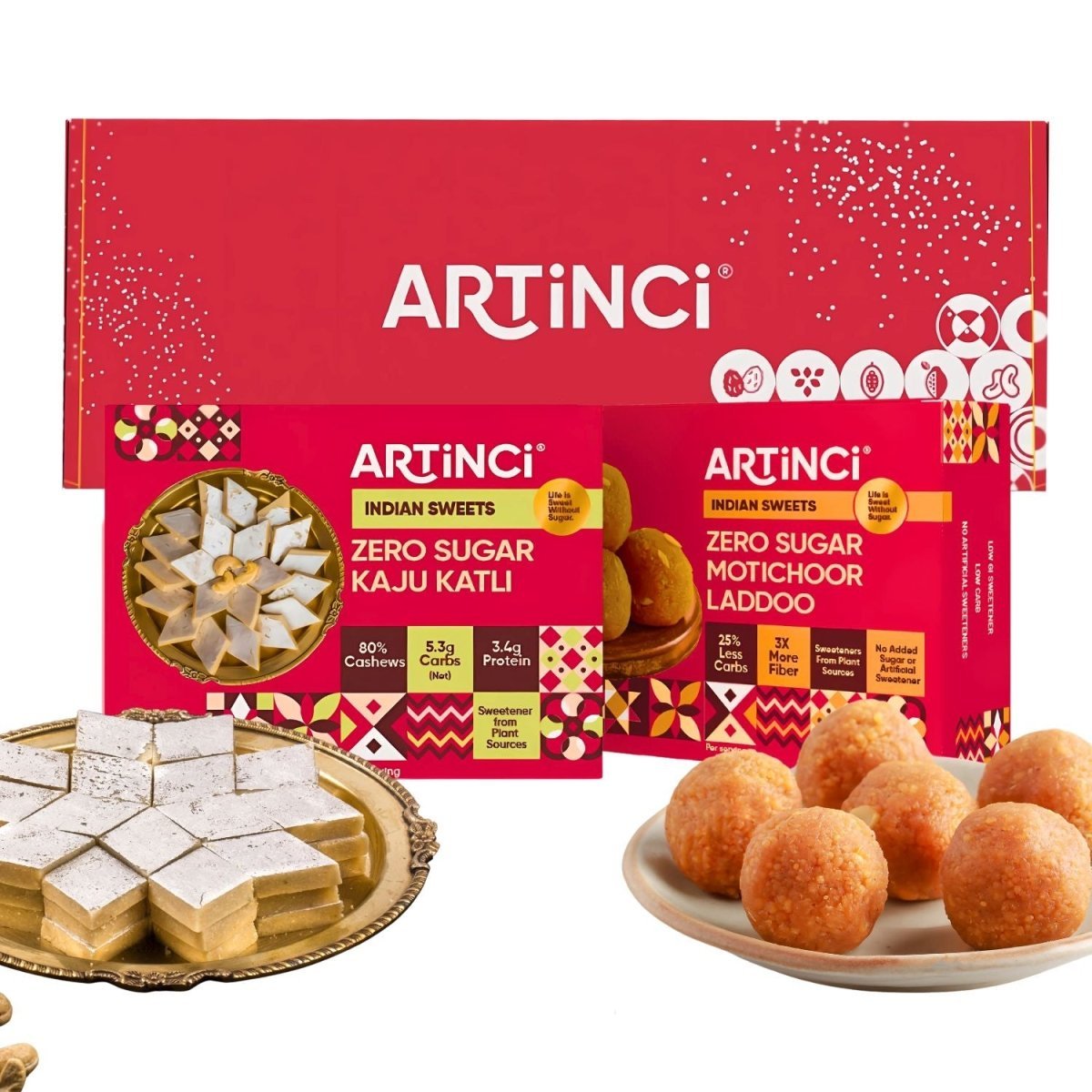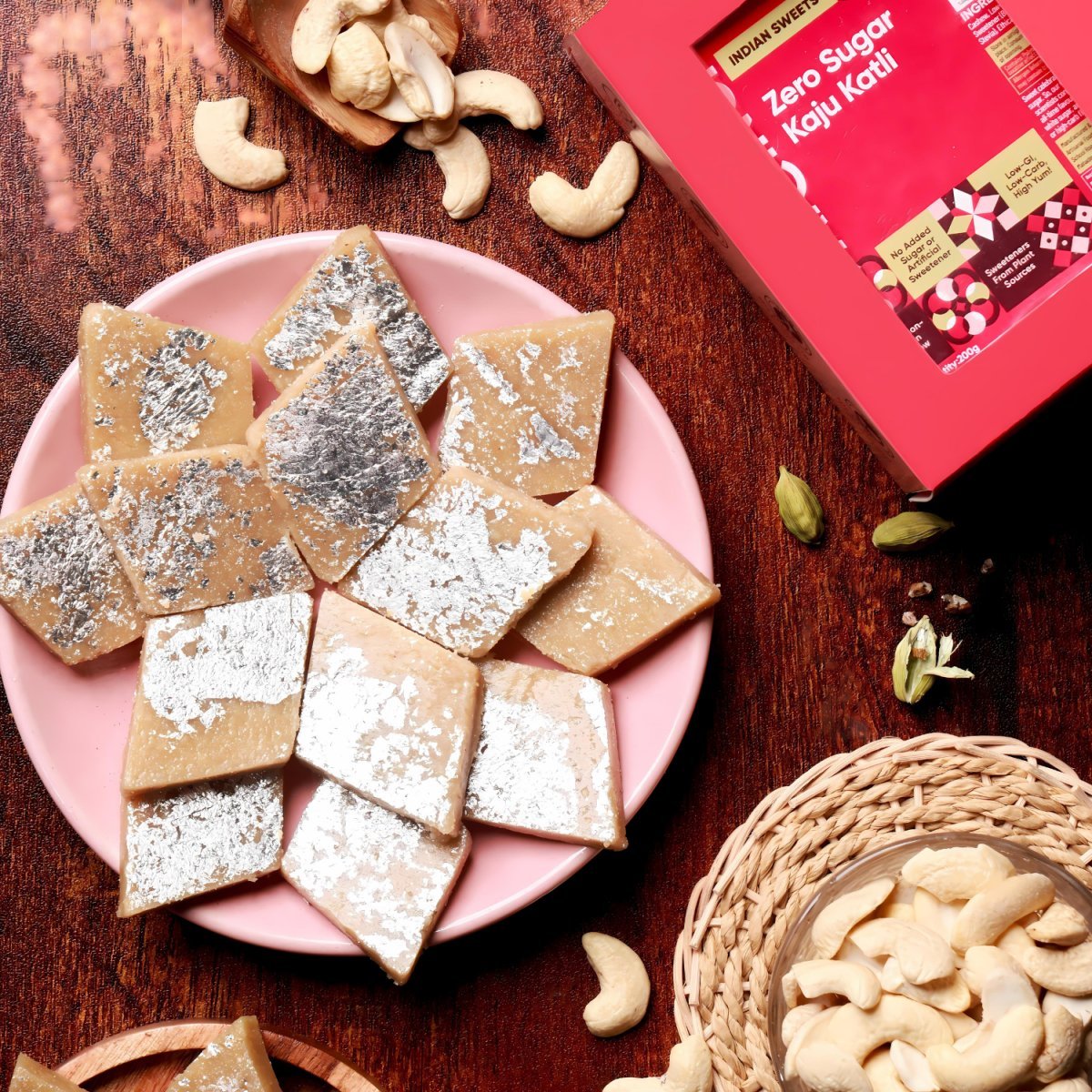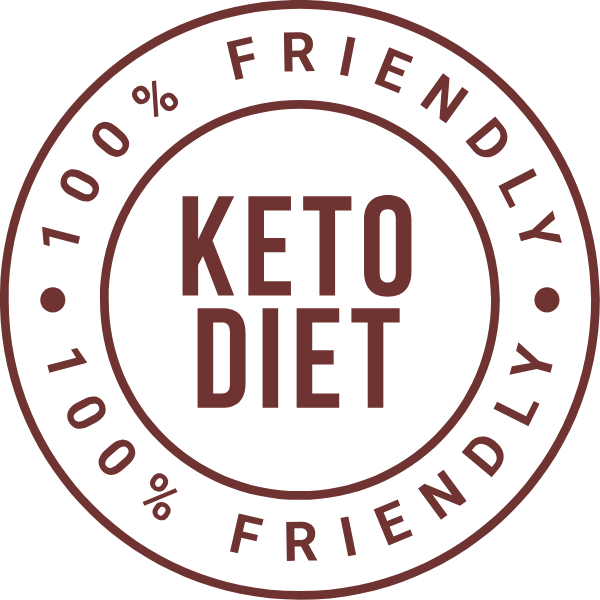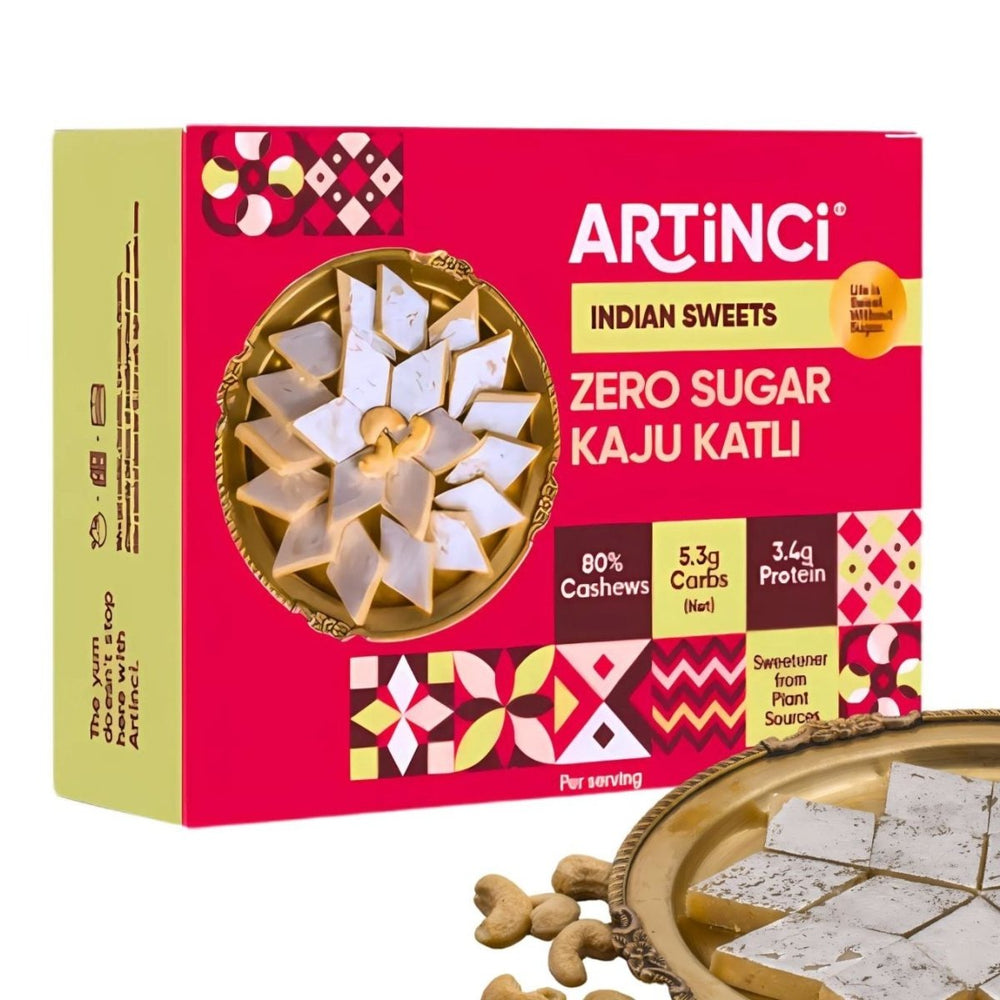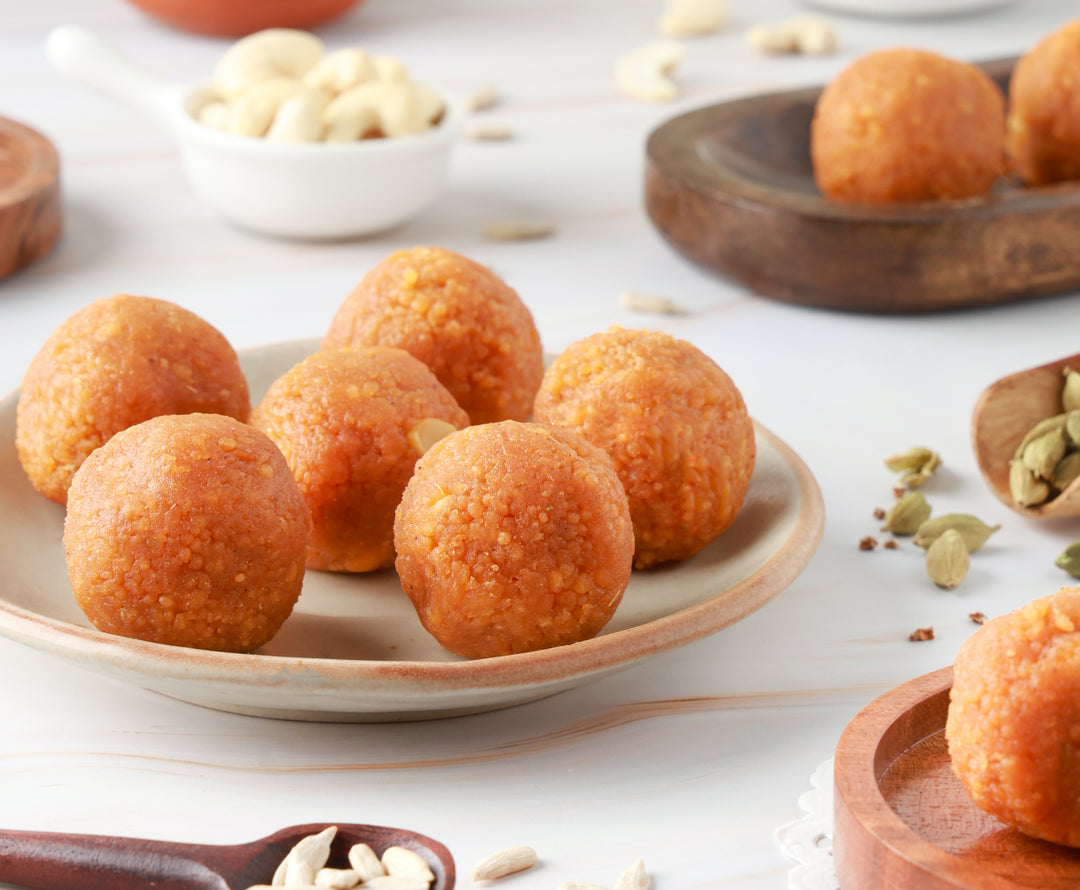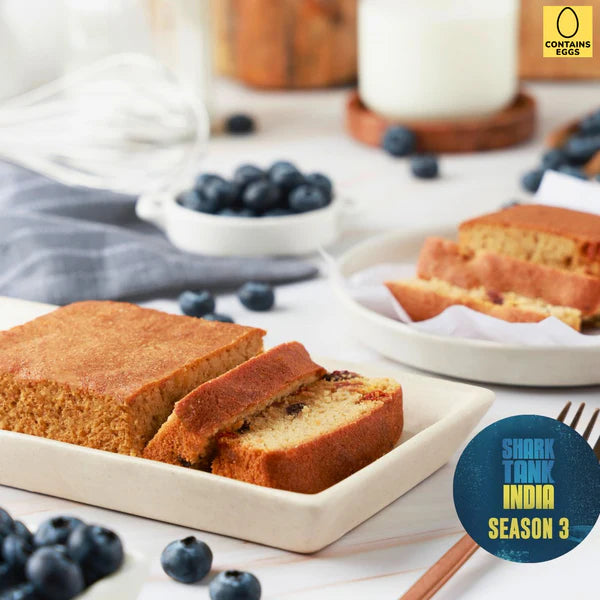Welcome to the world of sugar free joy!
Low Carb Sugar-Free Desserts & Snacks
Artinci was born out of Aarti's and Sumit's (Artinci's founders) abiding love for great-tasting dessert, while helping them stay committed to their health goals as well. As a result, Artinci makes delicious desserts with zero sugar, that are science and evidence-backed.
Aarti and Sumit come from a family of three generations of diabetics. They were themselves diagnosed pre-diabetic in 2012, and right there began a lifelong quest of a healthy, active lifestyle, including healthy swaps in food
Indulgent Halwas & Cozy Cakes


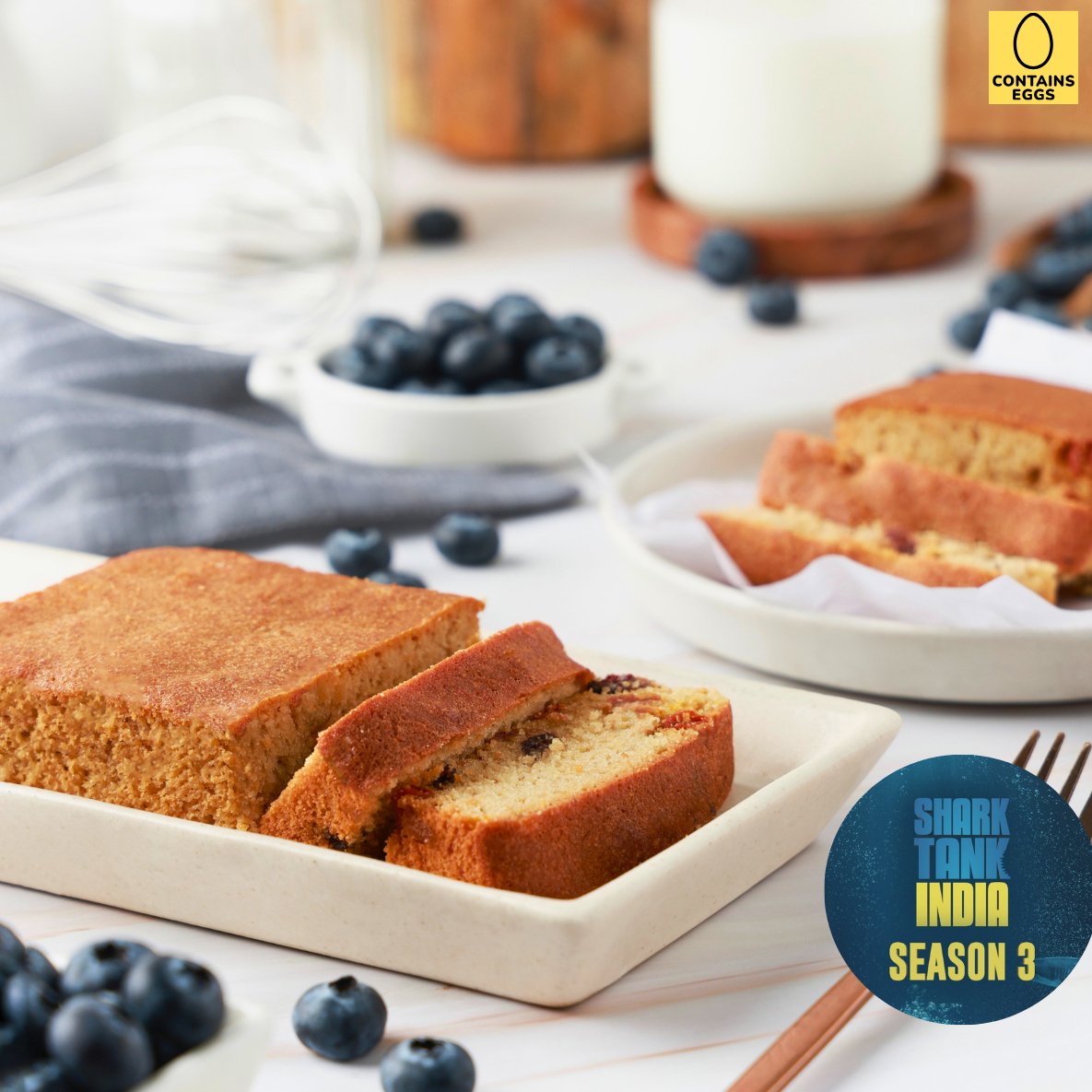
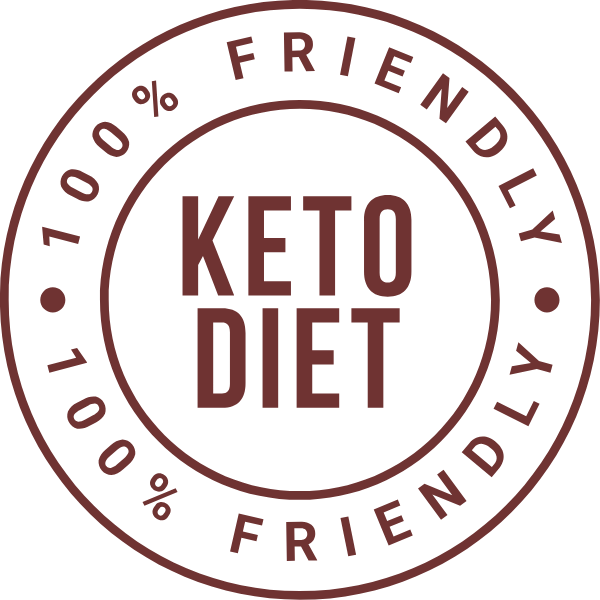

Berries Almond Cake - Made with 100% Almond Flour, Sugar Free, Keto, Gluten Free

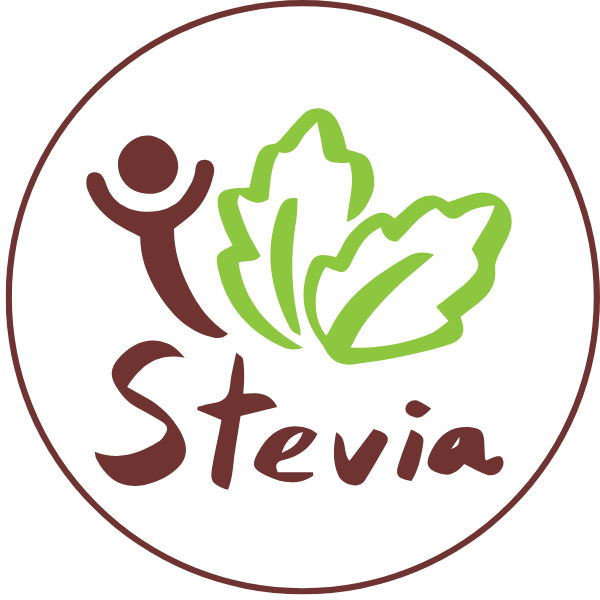

Winter special sugar free halwa combo @499



Aarti Laxman (Founder)
Artinci is founded by Aarti Laxman, a certified Metabolic coach in the Low-Carb Nutrition & Metabolic Health domain from dLife.in, India’s only legally tenable course in this subject—recognized by the NSDC (under the Ministry of Skill Development & Entrepreneurship, Govt. of India). It’s also internationally accredited by the CPD Standards Office UK, with a global record of 144 CPD hours—the highest for any course of its kind. The accreditation is both nationally valid and globally recognised in over 50+ countries..
Festive Gifting in Artinci
Let customers speak for us
All about Sugar and sugar-free

The dessert landscape is changing as health-conscious consumers look for treats that satisfy both their sweet cravings and nutritional goals. Protein-packed desserts have emerged as a game-changing solution, offering a perfect balance between indulgence and wellness. These innovative treats are rich in protein while keeping sugar content surprisingly low. From creamy Greek yogurt parfaits to rich protein brownies, these desserts are redefining what it means to enjoy something sweet without compromising health objectives. The demand for high-protein, low-sugar treats continues to surge as people recognize the benefits of: Sustained energy levels Better muscle maintenance Reduced sugar crashes Enhanced satiety Improved nutritional profiles As part of this trend, there's an increasing interest in the use of natural sweeteners like honey and jaggery, which are often considered better alternatives to artificial sweeteners. These natural options not only provide sweetness but also come with their own set of health benefits. Moreover, the incorporation of ingredients such as millet into these desserts is gaining popularity. Known as the "Poor Man’s Grain", millet is now taking over due to its high nutritional value and versatility in cooking. On the other hand, understanding the Glycemic Index (GI) of food is becoming increasingly important for those looking to maintain stable blood sugar levels. This index indicates how quickly a particular food causes a rise in blood sugar, which is crucial information for anyone managing their diet. The Evolution of Healthier Dessert Options The world of desserts has changed significantly, moving away from sugary treats to more nutritious options that satisfy both sweet cravings and health requirements. Ingredients traditionally used in desserts, such as refined flour and sugar, are now being replaced with protein-rich substitutes and healthier sweeteners like monk fruit, which can be an excellent choice for those aiming to cut back on sugar. Key Protein-Rich Ingredients Greek yogurt - A versatile base for parfaits, mousses, and frozen treats Cottage cheese - Creates creamy textures in cheesecakes and puddings Protein powder varieties - Whey, pea, and hemp proteins enhance baked goods Nut flours - Almond and coconut flour provide protein while remaining gluten-free Health-conscious consumers have embraced innovative high-protein desserts that rival their traditional counterparts: Popular Protein-Packed Treats Protein Ice Cream: Brands offering pints with 20g+ protein per serving Greek Yogurt Bark: Frozen treats topped with nuts and dark chocolate Protein Brownies: Made with black beans or chickpeas for added nutrition Chia Seed Puddings: Combining complete protein with omega-3 fatty acids, these chia seed puddings have become a popular choice These dessert alternatives have gained traction through social media, where food creators share recipes and techniques. Professional athletes and fitness enthusiasts promote these treats as post-workout rewards that align with their nutrition goals. The food industry has responded by developing new protein-enriched ingredients specifically designed for baking. These innovations include protein-fortified flour blends and natural sweeteners that maintain the familiar taste and texture of classic desserts while boosting their nutritional profile. There's also been a rise in the popularity of sugar-free products, which are often sought after due to growing health concerns about sugar consumption. However, it's important to understand whether these products are indeed healthier than regular ones. Moreover, the shift towards healthier dessert options isn't just limited to those who want to lose weight or maintain a healthy lifestyle. It's also beneficial for individuals managing health conditions such as diabetes. For instance, incorporating vegetarian proteins into one's diet can help maintain strength and health while managing diabetes. How Dietary Trends Influence Dessert Preferences The rise of specific dietary patterns has changed how consumers choose their desserts. These eating styles have created a significant demand for treats that align with their nutritional principles while satisfying sweet cravings. Low-Carb Diets Sugar-free chocolate mousse made with avocado Cheesecake bites using almond flour bases Protein-rich brownies with black beans Chia seed puddings sweetened with stevia Keto-Friendly Options Fat bombs incorporating MCT oils Cream cheese-based desserts Sugar-free ice cream with erythritol High-fat chocolate truffles Plant-Based Innovation Chickpea cookie dough Tofu-based chocolate puddings Protein bars using pea protein Cashew-based cheesecakes These dietary preferences have pushed manufacturers to create innovative solutions using alternative ingredients. You'll find desserts now featuring monk fruit sweetener, allulose, and sugar alcohols to keep carb counts low while maintaining sweetness. Plant-based proteins from peas, hemp, and rice have become standard additions to vegan treats. The intersection of these dietary trends has sparked creativity in recipe development. A single dessert might cater to multiple dietary preferences - imagine a keto-friendly, plant-based chocolate mousse made with avocado and pea protein, sweetened with monk fruit. This versatility has expanded the market reach of protein-packed desserts. The demand for these specialized treats has influenced both commercial products and home baking. Recipe blogs, cookbooks, and social media channels now regularly feature protein-rich dessert options tailored to specific dietary needs, making these treats accessible to a wider audience. The Nutrition Benefits of Protein-Packed Desserts Protein-packed desserts offer substantial nutritional advantages beyond satisfying your sweet tooth. These treats pack a powerful punch when it comes to supporting your fitness goals and maintaining a balanced diet. Key Benefits of High-Protein Desserts: Muscle Support: Consuming adequate protein helps preserve lean muscle mass during weight loss and supports muscle recovery after exercise Blood Sugar Control: The combination of protein with lower sugar content helps prevent rapid blood sugar spikes Extended Satiety: Protein-rich desserts keep you feeling satisfied longer, reducing the likelihood of additional snacking Metabolic Boost: Your body burns more calories digesting protein compared to fats and carbohydrates Natural sweeteners play a crucial role in these protein-enriched treats. Maple syrup provides minerals like manganese and zinc, while raw honey contains antioxidants and antibacterial properties. These alternatives to refined sugar create delicious desserts without compromising nutritional value. Additionally, erythritol, a popular sugar-free substitute, offers a low-calorie sweetening option that doesn't spike blood sugar levels. Optimal Protein Sources in Desserts: Greek yogurt (23g protein per cup) Cottage cheese (14g protein per 1/2 cup) Whey protein powder (20-25g protein per scoop) Plant-based options: Chickpea flour (20g protein per cup) Almond flour (6g protein per cup) Pea protein (15-20g protein per scoop) The protein content in these desserts ranges from 15-25g per serving - comparable to a small chicken breast. This substantial protein boost transforms traditional empty-calorie sweets into functional foods that support your health goals while delivering satisfying flavors and textures. Market Trends and Projections for High-Protein, Low-Sugar Desserts The healthy dessert market shows great potential for growth, with projections indicating a significant increase between 2025 and 2035. Industry analysts predict a compound annual growth rate of 8.7%, driven by increased consumer awareness of health and wellness. Key Market Segments Gaining Traction The following market segments are gaining popularity: Frozen desserts (protein-enriched ice creams, low-fat gelatos) Plant-based alternatives Functional yogurt-based treats Protein-packed baked goods Significant Shift in Product Development Strategies Manufacturers are now making a significant shift in their product development strategies by incorporating functional ingredients such as: Prebiotic fiber for gut health support Probiotics for immune system enhancement Plant-based proteins from pea, hemp, and quinoa Alternative sweeteners like monk fruit and stevia, which are often used in sugar-free products Innovation in Texture and Flavor Profiles Consumer demand has sparked innovation in texture and flavor profiles. Brands invest heavily in research and development to create products that maintain the indulgent mouthfeel of traditional desserts while delivering enhanced nutritional benefits. Broader Societal Trends Reflecting Market Expansion The market expansion reflects broader societal trends such as: Rising health consciousness among millennials and Gen Z Increased focus on preventive health measures Growing adoption of personalized nutrition Demand for clean-label products Varying Growth Patterns in Regional Markets Regional markets show varying growth patterns, with North America leading in product innovation and Asia-Pacific demonstrating the fastest growth rate. European markets focus on premium, artisanal protein-rich desserts with locally sourced ingredients. Technological Advancements Benefiting Sector Growth The sector's growth also benefits from technological advancements in ingredient processing and formulation, enabling better taste profiles and improved nutritional content in low-sugar treats. This is particularly relevant as the rise of sugar-free products has opened up a world of possibilities for those looking to manage their sugar intake, whether for weight loss or other health reasons. Awareness of Hidden Sugars in Sugar-Free Foods However, it's important to be aware that not all sugar-free products are created equal. There can be hidden sugars in sugar-free foods, so consumers need to be vigilant about what they are purchasing. Understanding Zero-Sugar Sweeteners Science Understanding the science behind zero-sugar sweeteners can provide valuable insights into making healthier choices. The Rise of Healthy Energy Bars In this evolving landscape, [healthy energy bars](https://olaben.com/blogs/olaben-blog/the-ultimate Leading Brands in the Protein-Packed Dessert Space Several innovative companies have changed the dessert industry with their protein-rich, low-sugar offerings. Halo Top Creamery is a pioneer in this space, introducing a game-changing ice cream line that delivers high protein content while keeping calories low. Their products typically contain 20g of protein per pint, using natural sweeteners and premium ingredients to maintain the creamy texture ice cream lovers expect. Chobani has expanded beyond traditional yogurt products to create indulgent protein-packed desserts. Their Complete line features dessert-inspired flavors with up to 25g of protein per serving, incorporating clean ingredients and probiotic cultures. The brand's commitment to natural ingredients and sustainable farming practices has earned them a loyal customer base. Other notable players in this space include: Quest Nutrition: Known for their protein cookies and bars with dessert-inspired flavors Enlightened: Offering keto-friendly ice cream bars and pints Danone: Producing protein-enriched yogurt desserts under various brand names These companies prioritize: Clean-label ingredients with transparent sourcing Sustainable packaging solutions Local ingredient sourcing when possible Reduced carbon footprint initiatives Upcycled ingredient utilization, such as using upcycled foods The success of these brands comes from their ability to balance taste with nutrition. They've mastered the art of creating desserts that satisfy sweet cravings while delivering substantial protein content. Their commitment to sustainability extends beyond ingredients to manufacturing processes and packaging choices, resonating with environmentally conscious consumers. Recent innovations from these brands include dairy-free alternatives, portion-controlled formats, and seasonal flavors that maintain their high-protein, low-sugar principles. Many have also introduced direct-to-consumer options, making their products more accessible to health-conscious consumers. Finding Balance: Indulgence Meets Nutrition in Protein-Packed Treats Protein-packed desserts represent a revolutionary approach to satisfying sweet cravings without compromising health goals. These functional foods bridge the gap between indulgence and nutrition, allowing you to enjoy delicious treats while maintaining a balanced lifestyle. Ready to create your own protein-rich desserts? Here are some simple ideas to get started: Mix Greek yogurt with protein powder and fresh berries for a quick parfait Blend cottage cheese with cocoa powder and a touch of honey for a chocolate mousse Bake protein cookies using almond flour, whey protein, and natural sweeteners Create protein ice cream by freezing blended bananas with your favorite protein powder The beauty of homemade protein desserts lies in their versatility and customization options. You control the ingredients, sweetness levels, and portion sizes to match your dietary preferences and nutritional needs. Key ingredients for protein-packed treats: Plant-based proteins (pea, hemp, rice) Whey or casein protein powders Greek yogurt Cottage cheese Natural nut butters Sugar alternatives (stevia, monk fruit) The rise of protein-packed desserts marks a significant shift in how we approach treats. These innovative options prove you can maintain your fitness goals while enjoying satisfying desserts that nourish your body and delight your taste buds.

2025’s Best Sugar-Free Cakes: Guilt-Free Indulgence Without Compromise
The sugar-free cake trend has taken 2025 by storm, changing the way we think about desserts. Health-conscious consumers now love these creative treats that bring pure joy without the guilt of sugar. Imagine digging into a rich, moist chocolate cake that won't raise your blood sugar or cause cravings. These aren't just fantasies - they're the reality of 2025's best sugar-free cakes. Bakers have become experts at making delicious desserts that meet various dietary needs: Zero Added Sugar: Natural sweeteners replace refined sugars Multiple Diet-Friendly Options: Keto, vegan, gluten-free variations Rich, Authentic Taste: No compromise on flavor or texture You'll find cakes that taste and feel just as good as their traditional versions, proving that healthy choices can still include sweet delights. From classic chocolate to unique flavor combinations, 2025's sugar-free cakes are redefining guilt-free baking. These cakes often use alternative ingredients that are both healthy and nutritious. For example, some bakers are using millet, a grain that's making a comeback because of its health benefits and versatility in baking. Moreover, the inclusion of vegetarian proteins in these recipes ensures that even those with specific dietary restrictions can savor these delightful treats without compromising on health. Get ready to discover a world where indulgence meets wellness - your taste buds won't believe these cakes are sugar-free. Popular Sugar-Free Cake Options The sugar-free cake landscape has evolved dramatically, offering a diverse range of options that cater to specific dietary needs while delivering exceptional taste. These innovative recipes showcase the perfect balance between health-conscious ingredients and indulgent flavors. Sugar-Free Low Carb Chocolate Crazy Cake This revolutionary cake stands out with its impressive nutritional profile: Net Carbs: 2g per serving Dietary Features: Egg-free, dairy-free, nut-free, grain-free, gluten-free Key Sweeteners: Monk fruit sweetener, sugar-free cocoa powder The Sugar-Free Low Carb Chocolate Crazy Cake draws inspiration from the Depression-era "Crazy Cake" or "Wacky Cake" - a resourceful creation born during times when eggs, butter, and milk were scarce. The modern adaptation maintains the original's spirit while incorporating health-conscious ingredients. Essential Components: Sesame flour (base ingredient) Ground flaxseed (binding agent) Baking soda + vinegar (leavening combination) Avocado or coconut oil (moisture element) The magic lies in the chemical reaction between baking soda and vinegar, creating a remarkably moist and fudgy texture without traditional binding agents. The sesame flour provides a neutral base that allows the chocolate flavor to shine through, while ground flaxseed adds structure and healthy omega-3 fatty acids. Alternative Options: Replace sesame flour with almond flour (if nut allergies aren't a concern) Experiment with different sugar-free sweeteners like allulose or stevia Try various sugar-free cocoa powder brands for different chocolate intensities The cake's success lies in its stable blood sugar response - you won't experience the typical sugar spikes or subsequent cravings associated with traditional chocolate cakes. The careful balance of ingredients creates a dessert that satisfies sweet cravings while maintaining ketogenic and low-carb dietary requirements. This recipe demonstrates how modern baking techniques can transform classic comfort foods into health-conscious options without sacrificing the indulgent experience of enjoying a slice of chocolate cake. It's worth noting that understanding the sweet swap is crucial when exploring sugar-free products. While they offer an alternative for those looking to manage their sugar intake, it's important to be aware of whether these products are really healthier than regular ones or if they contain hidden sugars despite being labeled as such. Furthermore, it's essential to consider the type of sweeteners used in these recipes. Some may include artificial sweeteners which could have their own health implications. Vegan Vanilla Cupcakes These delightful sugar-free treats bring classic vanilla flavor to your plate without compromising dietary preferences. The secret lies in creating a perfect vegan buttermilk base by combining plant-based milk with apple cider vinegar or fresh lemon juice. Key Ingredients: Unsweetened almond or oat milk Apple cider vinegar Monk fruit sweetener Vegan butter alternative Pure vanilla extract The recipe accommodates various dietary needs through flexible flour options. You can use all-purpose flour for traditional baking, or opt for a gluten-free blend featuring rice flour, tapioca starch, and xanthan gum. Frosting Options: Sugar-Free Vanilla Bean: Whipped vegan butter with monk fruit sweetener Berry Swirl: Natural fruit puree mixed with coconut cream Chocolate Dream: Sugar-free cocoa powder blended with avocado base Each cupcake contains only 3 net carbs, making them suitable for low-carb diets. The texture remains light and fluffy, while the monk fruit sweetener provides natural sweetness without the bitter aftertaste often found in sugar-free desserts. These cupcakes bake to a perfect golden color in just 18-20 minutes at 350°F (175°C). The result? A batch of moist, tender cupcakes that prove sugar-free baking can be both delicious and inclusive. Sweet Laurel Bakery's Approach to Healthier Baked Goods in 2025 Sweet Laurel Bakery is leading the way in the grain-free baked goods movement, changing the world of healthy desserts in 2025. This bakery in Los Angeles has perfected the skill of making indulgent treats with just a few, top-notch ingredients. Key Features of Sweet Laurel's Approach: Recipes limited to 10 ingredients or less 100% organic ingredients sourcing Zero artificial preservatives or additives Focus on sustainable packaging Custom blend of natural sweeteners The bakery's signature recipes showcase the versatility of clean ingredients. Their chocolate cake uses organic cacao, almond flour, and coconut oil, proving that simplicity can yield extraordinary results. Sweet Laurel's innovative approach extends to their proprietary sweetener blend, combining monk fruit with allulose for optimal taste and texture. Sweet Laurel's commitment to transparency reflects in their open-kitchen concept, where customers witness the careful preparation of their grain-free treats. The bakery offers hands-on workshops teaching customers to recreate their signature recipes at home. Their success has inspired a new generation of bakeries to embrace the "less is more" philosophy. Sweet Laurel's influence reaches beyond their storefront through their recipe book series and online baking courses, making healthy baking accessible to everyone. The Rise of Natural Sweeteners and Dietary Accommodations in Sugar-Free Cakes The sugar-free cake industry in 2025 has seen a significant shift with the introduction of natural sweeteners. Monk fruit sweetener has emerged as a revolutionary ingredient, offering zero calories and a glycemic index of zero. This natural substitute provides 150-200 times the sweetness of sugar without causing spikes in blood sugar levels, making it an ideal choice for desserts suitable for diabetics. To learn more about the importance of glycemic index in food choices, check out this article on why glycemic index is important. Allulose has also gained popularity in keto-friendly baking. This rare sugar occurs naturally in foods like figs and maple syrup, and it offers the same bulk and browning properties as regular sugar but with only 0.4 calories per gram. Bakers have reported better results in keeping their sugar-free creations moist and preventing crystallization. Modern sugar-free cakes now cater to multiple dietary requirements simultaneously: Keto-Compatible: Using allulose or monk fruit helps maintain ketosis while satisfying sweet cravings Vegan-Friendly: Plant-based ingredients replace traditional eggs and dairy Gluten-Free Options: Alternative flours like coconut and cassava create perfect textures Nut-Free Variations: Seed-based flours provide safe alternatives for allergy concerns The health benefits of these natural sweeteners go beyond just reducing sugar intake: They have no effect on insulin levels They contain no artificial additives or chemicals They help reduce inflammation responses They promote dental health They support a healthy gut microbiome Bakers have found that these sweeteners can be easily incorporated into their existing recipes. The molecular structure of allulose creates the same caramelization effect as sugar, while monk fruit extract enhances the flavor of chocolate-based desserts. These qualities allow for authentic taste experiences without compromising dietary goals. The versatility of natural sweeteners has sparked innovation in recipe development. Pastry chefs are experimenting with combining different alternatives to achieve the best sweetness profiles, creating unique blends that mimic the properties of traditional sugar while still offering health benefits. In addition to monk fruit and allulose, other sugar-free substitutes like erythritol are gaining popularity due to their distinct advantages. Erythritol, in particular, has its own set of benefits and risks compared to other sweeteners, making it an intriguing option for those looking to explore different sugar alternatives. While exploring natural sweeteners, it's also important to consider options like honey and jaggery. For a detailed comparison between these natural sweeteners and artificial ones, you can check this article discussing whether honey and jaggery are better than artificial sweeteners. Lastly, understanding the science behind these zero-sugar sweeteners can help make informed decisions about how to use them in baking. This article delves into [the science behind zero-sugar sweeteners](https://www.artinci.com/blogs/news/the-science-behind-zero-sugar-sweeteners), providing valuable insights into their health implications and suitability for various diets. Conclusion The world of desserts in 2025 is undergoing a significant change. Sugar-free cakes prove that we can enjoy delicious treats without compromising our health. Whether it's the creative Sugar-Free Low Carb Chocolate Crazy Cake or Sweet Laurel Bakery's simple yet satisfying approach, these desserts are challenging our perceptions of guilt-free baking. With the increasing popularity of natural sweeteners and flexible recipes, everyone can now savor a slice of joy, regardless of their dietary limitations. As we welcome these healthier dessert options into our lives, it's evident that sugar-free cakes in 2025 strike the ideal balance - pleasing your cravings while promoting your well-being. The future of desserts is not about settling for less - it's about making wise and delightful choices that elevate every occasion.

Glucose Management in Everyday Foods: How to Avoid Hidden Sugar Spikes
Hidden sugar spikes lurk in many everyday foods, silently impacting your health and well-being. Your body's glucose management system works tirelessly to process the foods you eat, but certain dietary choices can overwhelm this delicate balance. Understanding glucose management isn't just for people with diabetes - it's essential for anyone seeking optimal health. When your blood sugar levels spike and crash throughout the day, you might experience: Sudden energy crashes Increased hunger and cravings Difficulty concentrating Mood swings Weight management challenges The good news? You can take control of your glucose levels through smart food choices. By learning to identify hidden sugars and making strategic dietary decisions, you'll maintain steadier blood sugar levels throughout your day. This guide will show you practical strategies to navigate common food choices, from selecting the right carbohydrates to understanding portion sizes. You'll discover how simple switches in your daily meals can help you avoid those unwanted glucose spikes and maintain consistent energy levels. For instance, many people are looking for healthier options to replace refined sugar. This has led to a growing interest in both natural sweeteners like honey and jaggery, as well as artificial ones. Are Honey and Jaggery Better Than Artificial Sweeteners? Exploring these alternatives could be a significant step towards better glucose management. Understanding Glucose and Carbohydrates Your body transforms carbohydrates into glucose through a complex digestive process. When you eat carbohydrate-rich foods, enzymes in your digestive system break down these molecules into their simplest form - glucose. This glucose enters your bloodstream, triggering your pancreas to release insulin, which helps cells absorb and use this vital energy source. Managing your carbohydrate intake plays a crucial role in maintaining stable blood sugar levels. The amount and type of carbohydrates you consume directly impact how quickly your blood glucose rises and falls. A balanced approach to carbohydrate consumption helps prevent extreme fluctuations that can affect your energy, mood, and long-term health. Types of Carbohydrates and Their Effects on Blood Sugar Levels 1. Simple Carbohydrates These foods cause rapid blood sugar spikes due to their simple molecular structure. Your body breaks them down quickly, leading to a fast surge in glucose levels followed by an energy crash. However, with the rise of sugar-free products, there are now alternatives available that can help manage sugar intake without sacrificing taste. Table sugar Honey Fruit juice Candy Soda Baked goods 2. Refined Grains The refining process strips these grains of their fiber and nutrients. Without fiber to slow digestion, refined grains act similarly to simple sugars in your body. They quickly convert to glucose, causing sharp blood sugar elevations that can leave you feeling hungry shortly after eating. White bread White rice Regular pasta Processed cereals Crackers 3. Complex Carbohydrates Complex carbohydrates contain fiber and nutrients that slow down digestion and glucose absorption. This gradual release provides several benefits: Sustained energy levels throughout the day Better appetite control Reduced risk of blood sugar spikes Improved insulin sensitivity Enhanced digestive health The fiber in complex carbohydrates acts as a natural buffer, helping your body process glucose at a steady rate. When you eat whole grains and legumes, the fiber creates a gel-like substance in your digestive system that slows carbohydrate absorption. Some sugar-free sweeteners can be used as substitutes for traditional sugars without the associated spike in blood sugar levels. These sweeteners come with their own set of benefits and considerations which are worth exploring further. Moreover, millets, often referred to as the "poor man's grain", have gained popularity as a nutritious alternative to refined grains due to their low glycemic index and high nutrient content. Strategies to Avoid Hidden Sugar Spikes in Everyday Foods Making smart food choices helps you maintain stable blood sugar levels throughout the day. Here's how you can effectively manage glucose through strategic food selections: Smart Fruit Consumption Choose whole fruits instead of fruit juices Pair fruits with protein sources like nuts or cheese Limit dried fruits - they contain concentrated sugars Select lower-glycemic fruits like berries, apples, and pears Understanding the Glycemic Index Knowing about the Glycemic Index (GI) is crucial. The GI is an indicator of how quickly the food you are eating causes a rise in blood sugar. Opt for foods with a lower GI, such as those recommended in a low-glycemic index diet, to maintain stable glucose levels. Beverage Choices Matter Replace sodas with sparkling water infused with fresh fruit Opt for unsweetened tea or coffee Watch out for "healthy" drinks that pack hidden sugars Read labels carefully - many smoothies contain added sugars Protein Pairings for Balanced Blood Sugar Add nuts to your morning oatmeal Include Greek yogurt with your fruit snacks Incorporate eggs or lean meats into your meals Consider plant-based proteins like chickpeas or lentils Additional Tips for Effective Glucose Management Watch Out for Hidden Sugars in Processed Foods Check condiments like ketchup, BBQ sauce, and salad dressings Be mindful of "low-fat" products - they often contain added sugars Read ingredient lists - sugar has many different names Choose plain versions of foods and add your own seasonings Master Portion Control Use measuring cups for grains and starches Fill half your plate with non-starchy vegetables Limit carbohydrate servings to 1/4 of your plate Keep a food diary to track portion sizes Embrace Non-Starchy Vegetables When following a healthy eating plan, it's important to load up on leafy greens and include cruciferous vegetables like broccoli and cauliflower. You might also try zucchini noodles as a pasta alternative or add bell peppers, mushrooms, and asparagus to meals. Strategic Meal Planning Prepare balanced meals with protein, fiber, and healthy fats Space your meals evenly throughout the day Keep healthy snacks ready for hunger emergencies Plan your meals ahead to avoid impulsive food choices Smart Sweetener Choices When it comes to sweeteners, it's essential to choose wisely. For instance, understanding the truth about erythritol, a popular sugar-free substitute, can help you make informed choices. However, be cautious as not all sugar-free products are healthier; read about this [here](https://www.artinci.com/blogs/news/are-sugar-free-products-really-healthier-than- Special Considerations: Managing Blood Glucose with Gestational Diabetes or Type 2 diabetes Managing blood glucose requires specific strategies for individuals with gestational diabetes or type 2 diabetes. These conditions demand careful attention to food choices and meal timing to maintain stable blood sugar levels. Key Dietary Strategies: Pair carbohydrates with protein at every meal Space meals 2-3 hours apart Include a bedtime snack to prevent overnight blood sugar drops Monitor portion sizes using the plate method: 1/2 non-starchy vegetables, 1/4 protein, 1/4 nutrient-dense carbs Recommended Food Choices: Nutrient-Dense Carbs: Sweet potatoes Quinoa Steel-cut oats Lentils Black beans Blood Sugar-Friendly Proteins: Greek yogurt Eggs Fish Lean poultry Tofu Working with a registered dietitian can help create personalized meal plans that account for medication timing, exercise routines, and individual glucose responses. Regular blood sugar monitoring provides valuable feedback about how specific foods affect your levels. Pregnant women with gestational diabetes should aim for 15-30 grams of carbohydrates at breakfast, 45-60 grams at lunch and dinner, and 15-30 grams for snacks. Type 2 diabetes management might require different carbohydrate distributions based on individual needs and medication schedules. Conclusion Taking control of your glucose management starts with understanding the hidden sugars in your daily food choices. Your body responds differently to various carbohydrate sources, making it essential to develop awareness of these variations. By implementing smart food choices and portion control strategies, you can maintain stable blood sugar levels throughout your day. Consider these actionable steps for better glucose management: Read nutrition labels carefully to identify hidden sugar sources Plan your meals ahead to include balanced carbohydrate portions Track your food intake to understand your body's glucose responses Choose whole, unprocessed foods rich in fiber and nutrients Keep a food diary to identify patterns and make informed adjustments These small changes in your eating habits create significant impacts on your blood sugar stability. Each mindful food choice brings you closer to better glucose management and improved overall health. Remember that successful glucose management is a continuous journey of learning and adapting your food choices to support your body's needs.

Natural Sweeteners 101: Stevia, Monk Fruit & Erythritol for Diabetic-Friendly Baking
Living with diabetes doesn't mean giving up the joy of baking. Natural sweeteners have changed the way people with diabetes enjoy their favorite treats. Three standout options - stevia, monk fruit, and erythritol - have become popular for their ability to provide sweetness without raising blood sugar levels. In this guide, you'll discover: The science behind each sweetener's effect on blood sugar Specific health benefits for diabetic individuals Practical baking tips and conversion ratios Safety considerations and potential side effects Expert recommendations for daily consumption Whether you're new to diabetic-friendly baking or looking to expand your knowledge of sugar alternatives, this guide will help you make informed choices about natural sweeteners. You'll learn how to create delicious baked goods that align with your health goals, using these powerful plant-based alternatives to traditional sugar. Ready to transform your baking experience? Let's explore these game-changing natural sweeteners that are reshaping diabetic-friendly cuisine. 1. Stevia: A Powerful Sugar Substitute Stevia's journey from ancient sweetener to modern sugar alternative began with the Guarani people of South America, who used the leaves of Stevia rebaudiana to sweeten their traditional yerba mate tea. This remarkable plant produces compounds called steviol glycosides, making it 200-400 times sweeter than regular table sugar. The natural sweetening power of stevia comes from its unique molecular structure. Unlike artificial sweeteners, stevia extract contains zero calories and carbohydrates, making it an ideal choice for blood sugar management. Health Benefits for Diabetics Stevia offers significant advantages for people managing diabetes: Stimulates insulin production Helps stabilize blood glucose levels Contains antioxidant properties Supports weight management goals Reduces sugar cravings Research indicates stevia's antidiabetic properties extend beyond simple sugar replacement. Studies show it can improve insulin sensitivity and reduce post-meal blood glucose spikes. FDA Approval and Safety Guidelines The FDA has granted GRAS (Generally Recognized as Safe) status to high-purity stevia extracts. You'll find approved stevia products in several forms: Liquid drops Powdered extracts Granulated blends Baking mixes While stevia is safe for most people, some individuals might experience mild side effects: Slight digestive discomfort Subtle bitter aftertaste Potential interactions with certain medications To minimize these effects, start with small amounts and adjust gradually. The FDA recommends a daily intake limit of 4 mg per kilogram of body weight for steviol glycosides. When selecting stevia products, look for high-purity extracts labeled as "purified stevia" or "stevia extract." These forms offer the most consistent results for diabetic-friendly baking while maintaining optimal safety standards. 2. Monk Fruit: The Sweet Gourd Native to Southeast Asia, monk fruit (Siraitia grosvenorii) has emerged as a revolutionary sugar alternative for health-conscious bakers. This small, round fruit packs a powerful sweet punch through its natural compounds called mogrosides. The sweetness profile of monk fruit extract stands at 150-250 times sweeter than traditional sugar, allowing you to use significantly smaller amounts in your recipes. A mere 1/4 teaspoon of monk fruit sweetener can replace 1 cup of sugar in your baking endeavors. Key Properties of Monk Fruit: Zero calories and carbohydrates No impact on blood glucose levels Natural antioxidant properties Heat-stable for baking Clean, sweet taste without bitter aftertaste For diabetic individuals, monk fruit offers distinct advantages in blood sugar management. The mogrosides present in monk fruit extract don't affect insulin levels, making it an ideal choice for maintaining stable blood glucose readings throughout the day. Available Forms for Baking: Pure monk fruit extract powder Granulated blends with other natural sweeteners Liquid drops Baking-specific formulations Research indicates that monk fruit's antioxidant properties extend beyond its sweetening capabilities. These compounds help protect cells from oxidative stress and inflammation, providing additional health benefits beyond blood sugar control. The versatility of monk fruit in baking applications makes it particularly valuable for diabetic-friendly recipes. You can use it to create: Sugar-free cookies and cakes Low-carb bread and muffins Diabetic-friendly pie fillings Sugar-free icings and frostings The natural compounds in monk fruit remain stable at high temperatures, ensuring your baked goods maintain their sweetness throughout the baking process. This heat stability sets monk fruit apart from many other natural sweeteners. As the demand for healthier alternatives rises, products like monk fruit are leading the charge in the sugar-free revolution. However, it's essential to understand that not all sugar-free products are created equal. Some may contain hidden sugars, while others might not be as healthy as they seem when compared to regular products. Understanding these nuances is crucial when navigating the world of sugar-free labels, ensuring you make informed choices for your health and well-being. 3. Erythritol: The Low-Calorie Option Erythritol stands out in the sugar alcohol family as a natural sweetener found in fruits like grapes, melons, and mushrooms. Your body processes this crystalline powder differently from regular sugar, making it an excellent choice for diabetic-friendly baking. To understand more about its benefits and risks compared to other sweeteners, you can explore the truth about erythritol as a sugar substitute. Key Properties of Erythritol: 70% as sweet as regular sugar Only 0.24 calories per gram (compared to sugar's 4 calories) Natural occurrence in fermented foods Crystal-like appearance similar to sugar The unique metabolic pathway of erythritol sets it apart from other sugar alcohols. Your body absorbs about 90% of consumed erythritol through the small intestine and excretes it unchanged through urine. This process results in minimal impact on blood sugar levels and insulin response, which is crucial for people with diabetes. Blood Sugar Impact: Zero effect on glucose levels No insulin spike Safe for people with diabetes Doesn't contribute to tooth decay Understanding [why glycemic index is important](https://www.artinci.com/blogs/news/why-glycemic-index-is-important) can further illuminate why erythritol is a safe option for those monitoring their blood sugar levels. You'll find erythritol particularly useful in baking as it creates a cooling sensation in your mouth, similar to mint. This characteristic can enhance certain desserts like chocolate treats or mint-flavored baked goods. Digestive Considerations: Higher tolerance compared to other sugar alcohols Safe consumption up to 1 gram per kilogram of body weight Minimal digestive discomfort at recommended doses Gradual introduction recommended The granulated texture of erythritol makes it an ideal substitute in recipes calling for regular sugar. You can use it in a 1:1 ratio for most baking applications, though you might need to adjust quantities based on your taste preferences and the specific recipe requirements. Baking Tips with Erythritol: Add 1/3 more erythritol than sugar called for in recipes Combine with other sweeteners for enhanced taste Store in an airtight container to prevent clumping Use in recipes requiring sugar for structure and bulk Using Natural Sweeteners in Baking Recipes for Diabetics Baking with natural sweeteners presents unique challenges. These sugar alternatives behave differently from traditional sugar in recipes, affecting texture, moisture content, and browning properties. For instance, stevia doesn't provide the bulk that sugar does, while erythritol might create a cooling sensation in your baked goods. Strategies for Successful Baking with Natural Sweeteners 1. Combining Sweeteners for Better Results Mix stevia with erythritol to balance sweetness and bulk Blend monk fruit with allulose for improved texture Use a 1:1 sugar substitute blend for easier measurement 2. Adjusting Recipe Components Add extra fiber (psyllium husk, ground flax) for moisture retention Incorporate protein powder to improve structure Use xanthan gum (1/4 tsp per cup of flour) for better texture 3. Temperature and Timing Modifications Reduce oven temperature by 25°F when using erythritol Check baked goods 5-10 minutes earlier than usual Allow treats to cool completely before serving Expert Tips for Diabetic-Friendly Baking Start with tested recipes specifically designed for natural sweeteners Measure sweeteners precisely - they're often more concentrated than sugar Keep detailed notes of successful substitutions Test small batches before scaling up recipes Achieving Professional Results Creating diabetic-friendly baked goods requires practice and patience. Professional bakers recommend: Using fresh, high-quality ingredients Investing in an accurate kitchen scale Testing sweetness levels before baking Storing baked goods properly to maintain texture You'll achieve the best results by treating natural sweeteners as unique ingredients rather than direct sugar substitutes. Each sweetener brings distinct properties to your baking, creating opportunities for innovative, diabetes-friendly recipes that don't compromise on taste. Additionally, exploring whether honey and jaggery could be healthier alternatives to artificial sweeteners might also be worthwhile. Considerations for Diabetic-Friendly Baking Natural sweeteners offer promising alternatives for diabetic baking, but mindful consumption remains essential. Here's what you need to know about responsible usage: Practicing Moderation Monitor your daily intake of sugar substitutes Start with small amounts to assess personal tolerance Track blood sugar responses to different sweeteners Mix multiple sweeteners to achieve desired taste without overdoing any single type Managing Side Effects Digestive Issues: Large quantities can cause bloating or diarrhea Taste Adaptation: Your taste buds need time to adjust to sugar alternatives Individual Reactions: Some people may experience headaches or allergic responses Smart Usage Tips Keep a food diary to track sweetener consumption Space out servings throughout the day Stay hydrated when using sugar alcohols Consider combining sweeteners with fiber-rich ingredients to slow absorption Safety Measures Check with your healthcare provider before incorporating new sweeteners Read product labels carefully for hidden ingredients Purchase from reputable manufacturers Store sweeteners properly to maintain their quality Remember: Your body's response to natural sweeteners is unique. What works for others might not work for you. Listen to your body and adjust accordingly. Conclusion Natural sweeteners are changing the game for diabetic-friendly baking by offering safe and delicious alternatives to regular sugar. These plant-based options - stevia, monk fruit, and erythritol - give you the power to make treats that fit your health goals. The science behind these sweeteners shows that they have little effect on blood sugar levels, making them valuable tools for managing diabetes. But they offer more than just a sugar substitute; they also bring unique flavors and qualities that elevate your baking experience. By adding these alternatives to your baking routine, you can: Control Blood Sugar: Make desserts that satisfy your cravings without spiking your glucose levels Boost Nutrition: Enjoy extra health benefits like antioxidants found in monk fruit Explore Culinary Creativity: Play around with different sweetener combinations to achieve your preferred taste Support Long-term Health: Maintain a balanced approach to indulgence while effectively managing diabetes With natural sweeteners, you can master diabetic-friendly baking and discover new ways to cook creatively and healthily without sacrificing flavor or pleasure.






